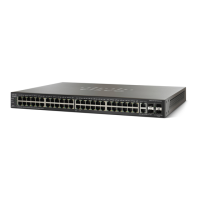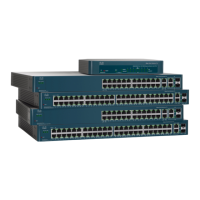Port Management
Link Aggregation
189 Cisco 500 Series Stackable Managed Switch Administration Guide
10
• MAC Address—Perform load balancing by source and destination MAC
addresses on all packets.
• IP/MAC Address—Perform load balancing by the source and destination IP
addresses on IP packets, and by the source and destination MAC addresses
on non-IP packets
STEP 3 Click Apply. The Load Balance Algorithm is saved to the Running Configuration file.
To define the member or candidate ports in a LAG.
STEP 1 Select the LAG to be configured, and click Edit.
The following fields are displayed for each LAG (only fields not on the Edit page
are described):
• Link State—Whether port is up or down.
• Active Member—Active ports in the LAG.
• Standby Member—Candidate ports for this LAG.
STEP 2 Enter the values for the following fields:
• LAG—Select the LAG number.
• LAG Name—Enter the LAG name or a comment.
• LACP—Select to enable LACP on the selected LAG. This makes it a dynamic
LAG. This field can only be enabled after moving a port to the LAG in the next
field.
• Unit/Slot—Displays the stacking member for which LAG information is
defined.
• Port List—Move those ports that are to be assigned to the LAG from the
Port List to the LAG Members list. Up to eight ports per static LAG can be
assigned, and 16 ports can be assigned to a dynamic LAG These are
candidate ports.
STEP 3 Click Apply. LAG membership is saved to the Running Configuration file.

